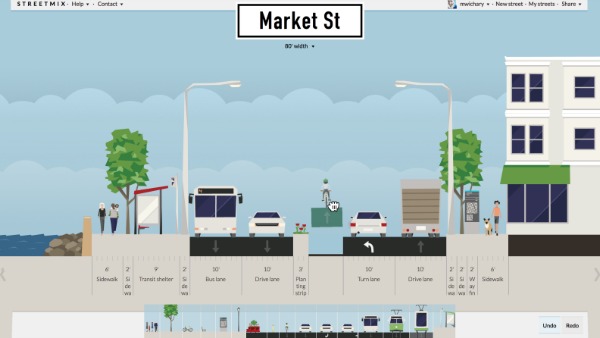Sick of fighting for cycling space on streets crowded with SUV-wielding soccer moms? Worry not, Good Citizen: The interwebs are here to help. Now you can redesign your city’s streets, leaving ample room for bike lanes, trees, and — fine — cars too. It’s all right at your fingertips.
The web application that makes it possible is called Streetmix. It was built by several members of Code for America, the nonprofit organization that teams up urban-minded activists and computer coders, then drops them into U.S. cities for year-long fellowships, all with the admirable goal of making local government suck less.
Streetmix is one of a number of web and smartphone apps designed to coax voters into being more active civic participants. Past Code for America projects have made it easier for citizens to request repairs to streets and sidewalks and other public infrastructure — and track the city’s progress.
“We’re trying to give people more of a voice, and make it easier for them to challenge plans that professional planners come up with that they might not be happy about,” says Lou Huang, a 31-year-old Code for America fellow in Las Vegas.

Code for America fellows at the hackathon where they made Streetmix.
It was Huang who first pitched the idea for Streetmix at a January hackathon (imagine a bunch of geeks locked in a room for a weekend guzzling Red Bull and punching code into their computer keyboards). The first version was thrown together in about six hours. The latest, improved version was unveiled Aug. 1.
So far, over 800 users have signed up for Streetmix, remixing more than 37,000 streets. Take Dexter Avenue in Seattle, reconfigured inside the Streetmix app to demonstrate how it could be redesigned to create more room for cyclists.
Some users have created their “dream streets,” as Huang calls them, with room for just pedestrians and bicycles, which is likely to … never happen. One user created Streetmix’s widest boulevard to date, equipping it with streetcars, bike lanes, sidewalks, bike racks, public transit shelters, trees, streetlamps, parklets, and its fair share of lanes of highway. Those smitten with convoluted Christopher Nolan movies can install a train modeled after the one that goes careening through a street in the movie Inception.
It’s an urbanist’s fantasy — but Streetmix is more than an amateur-planner’s wet dream. One person used Streetmix to inform a case study of cycletracks on M Street in Washington, D.C. Another took New Jersey’s Department of Transportation to task, using the app to illustrate how roads would look if the department followed its own “complete streets” policy.
Huang, who did streetscaping work for the urban design group of an architectural firm based in San Francisco prior to becoming a Code for America fellow, says that professional city planners are also catching on.
There are the usual planners, naturally, “who like building the most dangerous, car-filled monstrosities that they can,” says Huang. And there are those who use Streetmix as just a lighthearted game.
But as more urban planners tell Huang they’d like to incorporate the app into their own plans, and give citizens the ability to alter or propose street designs, he’s betting (boldly, we might add) that Streetmix will be more than a FarmVille for city nerds.
“This is going to revolutionize the way we interact with our communities on street design,” Huang says.
Great. Where can we install the next Platform 9 3/4?




